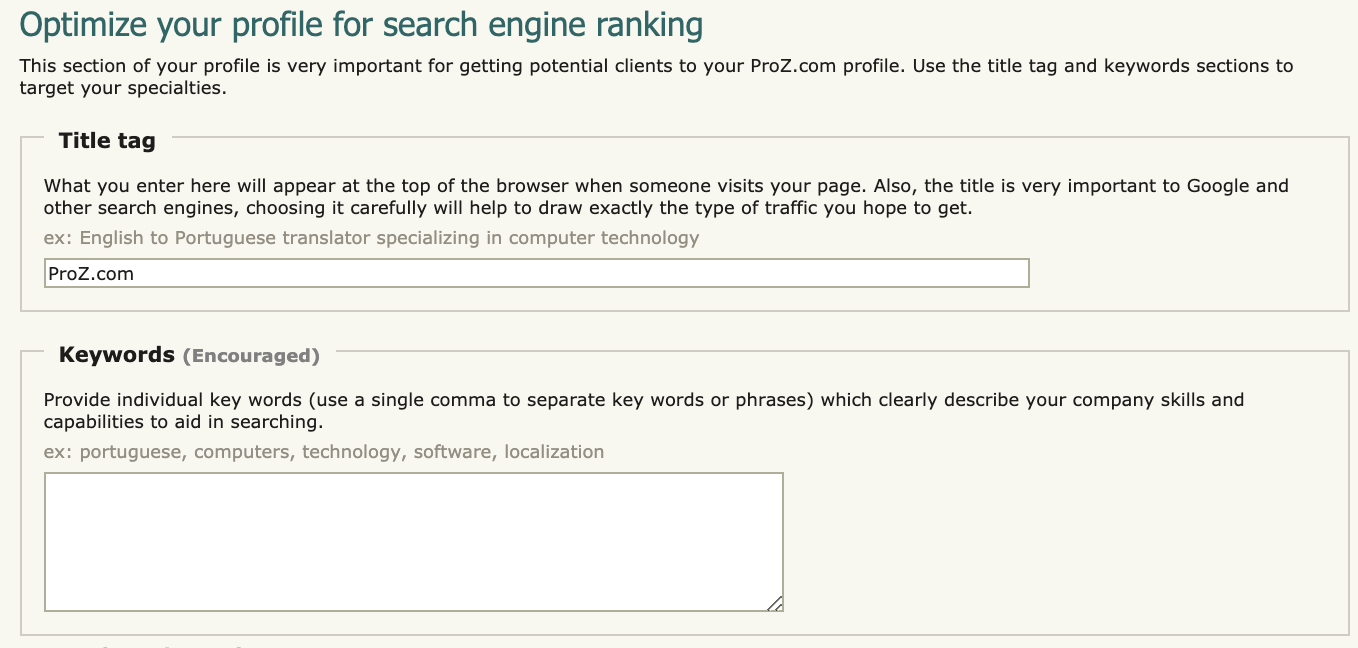
SEO, short for search engine optimization, is a cluster of practices and techniques for increasing the quality and quantity of visits of a website or a web page by targeting search engine users. Over half of all website traffic comes from organic search —that means, traffic from search engines that you aren’t paying for. In Google alone, 63,000 searches are conducted per second.
SEO settings affect not only how you show up on ProZ.com, but how (and if) you appear on search engines.

End clients who aren’t internalized in the world of translation are likely to try search engines first, and chances are that, if your profile is correctly set, you’ll be popping up on searches! If you are looking for local clients, particularly, this is very important: research shows that 4 in 5 consumers use search engines to find local businesses.
You can set up the SEO for your ProZ.com profile here.

The first thing to do before getting started, is to learn what your potential clients are searching for, and make sure to include those words and phrases on your profile.
ProZ.com hinges on specialized translation. There are a lot of free tools to help you figure out what the trending keywords are in your field(s) of specialization. Simply go to your preferred search engine, look for a free SEO generator, and you are sure to find some great tools that will allow you to search for the most used keywords in a particular industry and geographical area.
Once you have decided on the most effective keywords for the fields and markets that you are targeting, you need to keep in mind how you, as an Internet user, go about trying to find things in search engines. This is where the concept of head, body and long tail keywords comes in. What does that mean?
Head keywords are just 1 or 2 words. They turn up in a lot of searches, but they are so broad in scope that they’ll turn up in irrelevant searches most of the time.
Body keywords are 2 to 3 word phrases that are tailored to a more specific audience. They don’t turn up in as many searches, but they are more likely to be relevant and are less competitive.
Long tail keywords consist of longer sentences, usually 4 words or more, and they have a lower bulk of results but are highly tailored. Most search engine traffic nowadays comes from these.
So, for example, a combination of head, body and long tail keywords for my profile will look more or less like this: AVT, spanish translator, spanish subtitler, literary translator, audiovisual translator, english to spanish translator, spanish to english translator, english to spanish literary translator, spanish to english literary translator, english to spanish audiovisual translator, spanish to english audiovisual translator, english to spanish academic translator, spanish to english academic translator, english to spanish translator in argentina, spanish to english translator in argentina.
You can also keep those effective keywords in mind when writing your about me, as the content of your page is just as important as the keywords when ranking you in search engine results. Another important detail to remember is that search engines give priority placement to localized web pages. If you localize your about me and your keywords, search engines are going to rank you higher among the results.
There is another SEO field to customize in your ProZ.com profile, and that’s your title tag. That’s not just the text that will show up when you hover over your profile tab, but it’s actually the display title that will be shown in search engine result pages. It will be the first thing that people see when they read over the search results, and you want them to click on it.
So, what do you need to keep in mind here? First of all, search engine results will only show the first 60 characters, so stuffing your title tag with a whole paragraph of keywords is not a smart choice. It also needs to give off a professional image, of course, so avoid ALL CAPS and make sure not to make any typos.
The ideal tagline will be somewhere between 50 and 60 characters, and it should contain your languages and your key specialization fields. Now, when I say languages, I don’t mean the ISO code. Most end clients will not know what that, for example, PT means Portuguese, so you should make sure to use the full language name. Be clear, and target your content to clients, not to other translators.
One last thing to keep in mind: SEO is a long-term strategy, so it may take weeks or even months before you start seeing results. And, of course, market trends vary. If you are a quickly-changing industry, make sure to update your keywords regularly to keep up with what your clients are looking for.
Now, with all this in mind, it's time for you to get to work on your SEO strategy!
Editor's note: This blog post was published on November 22, 2019 as part of the ProZ.com Translation Article Knowledgebase. Find the original article here.



